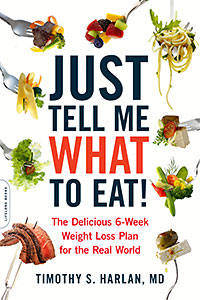How To...
Don't know how to do it? Dr. Gourmet explains common cooking techniques and the hows and whys of what they are and why they work. More Cooking Techniques
Just Tell Me What to Eat!
The Delicious 6-Week Weight Loss Plan for the Real World
Timothy S. Harlan, MD, FACP has counseled thousands of his patients on healthy, sustainable weight loss. Now he's compiled his best tips and recipes into a six-week plan for you to learn how to eat great food that just happens to be great for you.
Get the prescription for better health as well as healthy weight loss, including:
- What to eat
- How to cook it
- When to eat it
- What to eat at a restaurant
- What to eat if you're in a hurry
- and best of all....
- Why eating great food is the best health decision you'll ever make.
Cooking Techniques
Baking Tips
I have so much enjoyed baking this year. Over the first few months of 2007 Dr. Gourmet recipes have been focused on baked goods -- mostly muffins and quick breads. The challenge of balancing great flavor and texture with a healthy, high fiber, lower calorie muffin or bread has been fun and tasty. I have learned a few tips and I wanted to share them with you.
Tip #1 - Don’t be afraid of whole grains in your baked goods. Using a ratio of about 1/3 whole wheat flour with 2/3 all-purpose flour boosts the fiber content by about 2 grams in an average serving.
Tip #2 - Add a little wheat germ to your batters. Like the whole wheat flour wheat germ boosts the fiber content but also adds a slightly nutty and sweet flavor to baked goods. If a batter that you are making is too liquid, adding wheat germ instead of flour to “stiffen” it up can give you more control. Go slowly adding only about a tablespoon at a time.
Tip #3 - All baked goods need at least a little fat. The fat helps with how the carbon dioxide created by the baking soda and baking powder is trapped to create a lighter and more airy muffin or bread. I have found that the combination of a tablespoon or two of a spread and an egg yolk works fantastically well.
Tip #4 - Use foil muffin liners instead of paper. Use non-stick aluminum foil to line loaf pans. This makes it easy to remove muffins and breads from their pans and clean up is a snap.
Tip #5 - Frothing the egg whites to about triple the volume adds some air and lightness to the muffins and breads.
Tip #6 - Stir together the moist ingredients like eggs, spread, applesauce, pumpkin, yogurt, etc. first and then sift in the flour and other dry ingredients. Fold the two together and then add liquid ingredients. In most quick breads and muffins it is the reaction of the baking powder and baking soda with an acid that sets off the chemical reaction to create carbon dioxide. Adding liquids like buttermilk and juice later in the process delays this chemical reaction until the end of mixing the ingredients.
Tip # 7 - Measure all ingredients as exactly as possible. Baking is essentially like working with a big chemistry set and taking care to mix the ingredients (chemicals) precisely makes for the best muffins and quick breads.
Tip # 8 - A light sprinkle of about 2 teaspoons of brown sugar on the top of muffins or breads before baking makes for a lovely glaze without adding too many calories.
Tip #9 - The most important tip is to begin baking on your own. That way you have great, healthy baked goods available for a quick breakfast. So much better than fast food and so easy to make. Start baking this week and each week add a new recipe. Over time you’ll have all the ingredients in the pantry to knock out breakfast for the week in about a half hour on Sunday.
Baking Recipes
Apple
Cinnamon Bread
Banana Nut Bread
Banana Nut Muffins
Blueberry Muffins
Raisin Bran Muffins
Carrot Muffins
Orange Cranberry Muffins
Pumpkin Nut Muffins
Zucchini Bread
Whole Wheat Biscuits
Related Resources
Apple types
Applesauce
Baking muffins
Baking Soda
Brown Eggs
Brown Sugar
Buttermilk - Making
Buttermilk - what is it?
Buttermilk in baking
Cinnamon
Egg Whites
Egg sizes
Extracts vs oils
Maple Syrup
Non-stick Pans
Oatmeal
Oven temperatures
Pure Vanilla Extract
Raisins
Sift
Wheat Flours
Whisk

